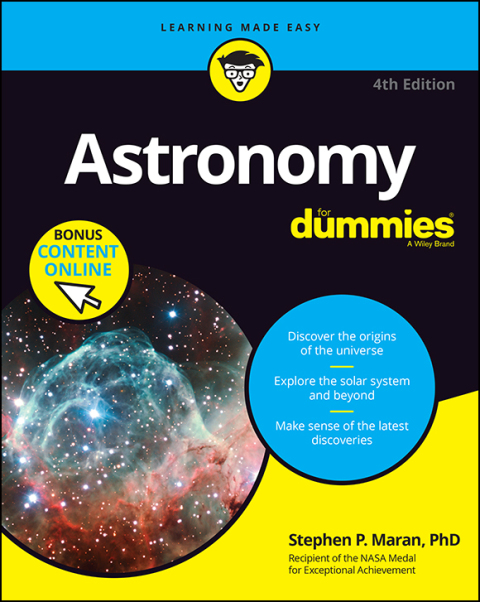Description
Efnisyfirlit
- Cover
- Introduction
- About This Book
- Foolish Assumptions
- Icons Used in This Book
- Beyond the Book
- Where to Go from Here
- Part 1: Getting Started with Astronomy
- Chapter 1: Seeing the Light: The Art and Science of Astronomy
- Astronomy: The Science of Observation
- What You See: The Language of Light
- Gravity: A Force to Be Reckoned With
- Space: A Commotion of Motion
- Chapter 2: Join the Crowd: Skywatching Activities and Resources
- You’re Not Alone: Astronomy Clubs, Websites, Smartphone Apps, and More
- Visiting Observatories and Planetariums
- Vacationing with the Stars: Star Parties, Eclipse Trips, Dark Sky Parks, and More
- Chapter 3: Terrific Tools for Observing the Skies
- Seeing Stars: A Sky Geography Primer
- Beginning with Naked-Eye Observation
- Using Binoculars or a Telescope for a Better View
- Planning Your First Steps into Astronomy
- Chapter 4: Just Passing Through: Meteors, Comets, and Artificial Satellites
- Meteors: Wishing on a Shooting Star
- Comets: The Lowdown on Dirty Ice Balls
- Artificial Satellites: Enduring a Love–Hate Relationship
- Part 2: Going Once Around the Solar System
- Chapter 5: A Matched Pair: Earth and Its Moon
- Putting Earth under the Astronomical Microscope
- Examining Earth’s Time, Seasons, and Age
- Making Sense of the Moon
- Chapter 6: Earth’s Near Neighbors: Mercury, Venus, and Mars
- Mercury: Weird, Hot, and Mostly Metal
- Dry, Acidic, and Hilly: Steering Clear of Venus
- Red, Cold, and Barren: Uncovering the Mysteries of Mars
- Differentiating Earth through Comparative Planetology
- Observing the Terrestrial Planets with Ease
- Chapter 7: Rock On: The Asteroid Belt and Near-Earth Objects
- Taking a Brief Tour of the Asteroid Belt
- Understanding the Threat That Near-Earth Objects Pose
- Searching for Small Points of Light
- Chapter 8: Great Balls of Gas: Jupiter and Saturn
- The Pressure’s On: Journeying Inside Jupiter and Saturn
- Almost a Star: Gazing at Jupiter
- Our Main Planetary Attraction: Setting Your Sights on Saturn
- Chapter 9: Far Out! Uranus, Neptune, Pluto, and Beyond
- Breaking the Ice with Uranus and Neptune
- Meeting Pluto, the Amazing Dwarf Planet
- Buckling Down to the Kuiper Belt
- Viewing the Outer Planets
- Hunting New Planet Number Nine
- Part 3: Meeting Old Sol and Other Stars
- Chapter 10: The Sun: Star of Earth
- Surveying the Sunscape
- Don’t Make a Blinding Mistake: Safe Techniques for Solar Viewing
- Fun with the Sun: Solar Observation
- Chapter 11: Taking a Trip to the Stars
- Life Cycles of the Hot and Massive
- Star Color, Brightness, and Mass
- Eternal Partners: Binary and Multiple Stars
- Change Is Good: Variable Stars
- Your Stellar Neighbors
- How to Help Scientists by Observing the Stars
- Star Studies to Aid with Your Brain and Computer
- Chapter 12: Galaxies: The Milky Way and Beyond
- Unwrapping the Milky Way
- Star Clusters: Meeting Galactic Associates
- Taking a Shine to Nebulae
- Getting a Grip on Galaxies
- Joining Galaxy Zoo for Fun and Science
- Chapter 13: Digging into Black Holes and Quasars
- Black Holes: Keeping Your Distance
- Quasars: Defying Definitions
- Active Galactic Nuclei: Welcome to the Quasar Family
- Part 4: Pondering the Remarkable Universe
- Chapter 14: Is Anybody Out There? SETI and Planets of Other Suns
- Using Drake’s Equation to Discuss SETI
- SETI Projects: Listening for E.T.
- Discovering Alien Worlds
- Astrobiology: How’s Life on Other Worlds?
- Chapter 15: Delving into Dark Matter and Antimatter
- Dark Matter: Understanding the Universal Glue
- Taking a Shot in the Dark: Searching for Dark Matter
- Dueling Antimatter: Proving That Opposites Attract
- Chapter 16: The Big Bang and the Evolution of the Universe
- Evidence for the Big Bang
- Inflation: A Swell Time in the Universe
- Dark Energy: The Universal Accelerator
- Universal Info Pulled from the Cosmic Microwave Background
- In a Galaxy Far Away: Standard Candles and the Hubble Constant
- The Fate of the Universe
- Part 5: The Part of Tens
- Chapter 17: Ten Strange Facts about Astronomy and Space
- You Have Tiny Meteorites in Your Hair
- A Comet’s Tail Often Leads the Way
- Earth Is Made of Rare and Unusual Matter
- High Tide Comes on Both Sides of Earth at the Same Time
- On Venus, the Rain Never Falls on the Plain
- Rocks from Mars Dot Earth
- Pluto Was Discovered from the Predictions of a False Theory
- Sunspots Aren’t Dark
- A Star in Plain View May Have Exploded, but No One Knows
- You May Have Seen the Big Bang on an Old Television
- Chapter 18: Ten Common Errors about Astronomy and Space
- “The Light from That Star Took 1,000 Light-Years to Reach Earth”
- A Freshly Fallen Meteorite Is Still Hot
- Summer Always Comes When Earth Is Closest to the Sun
- The Back of the Moon Is Dark
- The “Morning Star” Is a Star
- If You Vacation in the Asteroid Belt, You’ll See Asteroids All Around You
- Nuking a “Killer Asteroid” on a Collision Course for Earth Will Save Us
- The Sun Is an Average Star
- The Hubble Telescope Gets Up Close and Personal
- The Big Bang Is Dead
- Part 6: Appendixes
- Appendix A: Star Maps
- Appendix B: Glossary
- Sky Measures
- About the Author
- Supplemental Images
- Connect with Dummies
- End User License Agreement







Reviews
There are no reviews yet.